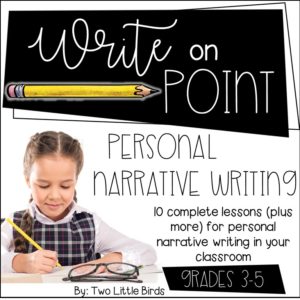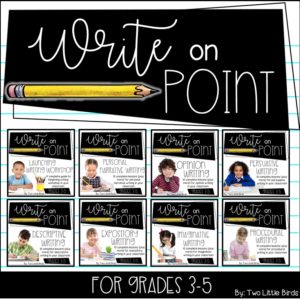Teaching personal narratives is always fun. Kids love to tell stories and putting their stories to paper is exciting, but it can also be challenging. Focusing on one memory or event, zooming in on the moments that are worth telling, and captivating their audience in the process are all a part of the narrative writing process that helps students develop as storytellers and writers.

Carefully developing mini-lessons that will help students as they write their own personal narratives is an important part of planning your narrative writing unit. Here are a few ideas for anchor charts as you are planning your narrative writing unit.
1. Thinking of ideas
Narrative writing tells a story and a personal narrative tells a story from your own experiences. Discuss personal narratives, important parts to include in a personal narrative, and how to think of ideas for your personal narrative.
Have students think of ideas and share topics that could be their own personal narratives. Have them generate a list of their own ideas.
2. Elements of a personal narrative
Discuss the story elements of the story: the setting, characters, problem, solution, and how a story has a clear beginning, middle, and end. As authors, we have to limit the number of characters and places the characters visit so that we are staying zoomed in on small moments.

Create an anchor chart of story elements that students will include in their personal narrative. Encourage students to consider where their memory or event took place, use a sequence of events so that it is clear to the reader, add details that are important and stick with the small moment of the memory, develop the characters to help the reader get to know them, show your feelings, use your voice as a writer.
These are all ideas that will help as students begin their writing. Incorporating all of these elements in a clear and concise way will keep the story interesting to your reader.
3. Using voice in your writing
When you put feelings into your writing, your reader will get to know you and your story will be one that they want to read. Encourage students to use voice in their writing so that their writing sounds like them. Their voice becomes their own writing style and writing personal narratives is the perfect time to explore that style. You can use vivid language and details, express thoughts and feelings, and let your personality show.

Students are the experts of their own narratives!
4. When to start a new paragraph
Students become so focused sometimes on how long a paragraph needs to be that they forget that the quality of the paragraph is just as important as the length.
Discuss with your students:
- A paragraph starts on a new line and indents.
- Use transition words to change paragraphs smoothly.
- When do we start a new paragraph?
- Should we simply count 5-6 sentences and then indent?
Create an anchor chart as a reminder to start a new paragraph when someone new is introduced in the story, when a new event occurs, when a new person is speaking, when the setting changes, or the topic/idea changes.
5. Adding in more details
Adding details to writing while revising is an important step because while writing personal narratives only your students know the details of their stories. They want their readers to know all they need to know!

How can you add details?
- Add in adjectives
- Show more action, use verbs to help show the action
- Use dialogue when you can
- Show your feelings about the events/memories
- Add in details that only YOU know! Your reader was not there, but YOU were!

Looking for more ideas for writing workshop?
You can find more tips and ideas for narrative writing in this post.
Find some ideas and tips for persuasive writing in this post.
And check out all of my posts about writing workshop in one place!








